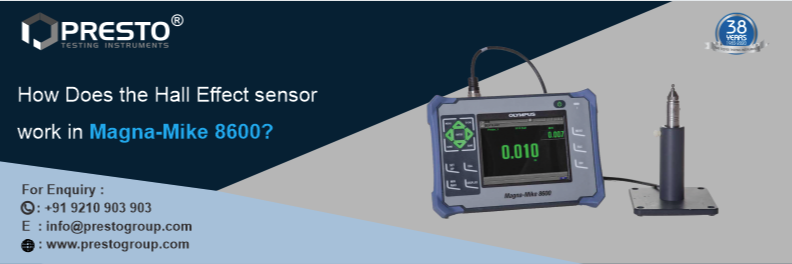How Does the Hall Effect Sensor Work in Magna-Mike 8600?

PET bottles are widely utilized in a variety of manufacturing sectors for packaging and refilling purposes. It is regarded as the most essential packaging material that will be used to store a large number of products. The quality and safety of the contents contained within are also ensured by PET packaging. Therefore, it is important to check the quality of PET products in order to deliver accurate products to your customers. Checking the thickness of PET bottle walls will help you to evaluate the uniformity of the goods is required to assure the quality and strength of the bottles. Thus, with the use of a bottle wall thickness gauge, it will be easy for you to measure the thickness of non-ferrous products like Plastics, performs, glass, water tanks, foam, aluminum, PET, etc. This lab testing instrument works on Hall Effect technology.
Here in this blog, we are going to discuss how the Hall Effect sensor of wall thickness gauge works. We will also discuss how you can easily test the thickness of PET bottles with the help of this lab testing equipment.
What is PET bottle wall thickness gauge?
The Magna-Mike 8600 wall thickness gauge is one of the effective testing instruments that can be used for non-ferrous materials like PET bottles to test their quality. The PET bottle wall thickness gauge works on the principle of Hall Effect technology, a simple procedure that makes it useful to make the repeatable measurements of non-ferrous materials.
This wall thickness gauge 8600 is really easy to use. When the magnetic probe is held or scanned on one side of the test material and a tiny target ball (or disc or wire) is placed on the opposing side or dropped into a container, then the measurements will be taken. This Magnamike Hall Effect sensor on the probe determines the distance between the probe tip and the target ball. The measurements are promptly shown as an easy-to-read digital thickness readout on the huge color thickness display.
This lab testing instrument will easily measure the wall thickness of several materials and have wide applications in the packaging industry.
Below we have listed the features and technical specifications of this amazing lab testing equipment.
Features of Magnamike 8600 wall thickness gauge
The MagnaMike 8600 is flexible, rapid, and reliable testing equipment that measures material thickness using Non-Destructive Techniques (no cutting or sectioning required). Fiberglass, metals, ceramics, glass, and polymers have their thicknesses measured with this testing gauge so that the right quality of materials will be delivered. This Olympus Magnamike 8600 wall thickness gauge has been equipped with several advanced features to make this lab testing equipment more unique and useful. Below we have listed the features of this testing instrument.
- Measurement-based on probe’s Hall Effect sensor
- Digital Display readout
- Repeatability of test measurements of the test sample
- Measurements through Target Ball or wire or Disk using Magnetic field
- Expandable Thickness range up to 25.4mm (1.00 in.)
- Replaceable Wear Caps – Standard and Chisel type
- Expanded target selection – 3/16 and ¼ in. magnetic target balls or Wire target
- Larger Color VGA display
- Fast measurement update rate 60Hz
- Programmable Instrument lock with password
- RS-232/USB/VGA output Communication Modes
- Direct Interface to Excel spreadsheet
- WINXL interface program
- Generate onboard reports
- Designed with IP67 rating
- Expanded alphanumeric data logger
- Save and recall option for stored calibration file
- Bench style case with improved gage stand
- Low and high reading Alarm
- Ability to export file to MicroSD card in .txt and CSV format
- Strip Chart view
- Inbuilt Calibration Facility
- Selectable measurement units – mm or inch
- Ability to store Thickness readings in one of the standard file formats – Incremental, Sequential, Sequential with Custom point, 2-D grid
These are some advanced features that have been equipped in this lab testing equipment. Now, let us focus on its technical specifications.
Technical specifications of Magnamike 8600 wall thickness gauge
- Ion battery
- Keypad – Japanese, English, International, Chinese
- Languages Supported – English, Spanish, French, German, Japanese, Chinese, Portuguese, Swedish, Norwegian, Dutch, Polish, Russian, Hungarian, Czech, Italian
- Data Storage – Onboard and removable 2 GB Micro SD card
- Battery life (Optional) – 12 h to 13 h (lithium-ion)
- Power requirements – AC Mains: 100 V AC to120 V AC, 200 V AC to 240 VAC
- Display type – Full VGA (640 x 480 pixels) transflective color LCD
- Display dimensions (W x H, Diag.) – 117 mm x 89 mm, 146 mm (4.62 in. x 3.49 in., 5.76 in.)
- Min/Max capture mode – Captured at 60 Hz measurement rate
- Display update rate – 4, 8, 16, and 20 Hz
- Alarm – High and Low alarms
- Resolution – 1 mm (0.01 in.), 0.01 mm (0.001 in.), 0.001 mm (0.0001 in.) (Depending on thickness range)
- Data logger – Internal file-based alphanumeric data logger
- Maximum Thickness range: Up to 25.4mm (1.00 in.)
- Minimum Thickness range: 0.001mm (0.0001 in.)
Now, let us discuss how this Hall Effect works in Magnamike 8600 wall thickness gauge.
How do Hall Effect gages work in wall thickness gauge?
Hall Effect gauges may theoretically measure any non-magnetic material with a geometry that allows a probe tip to be placed on one side of a wall and a tiny target such as a steel ball to be placed on the other, up to a maximum thickness of around 1 inch or 25 mm. Thus the measurements will be directly displayed on the large color thickness display as an easy-to-read digital thickness reading.
A Hall Effect sensor is a type of electronic semiconductor that reacts to changes in magnetic fields by altering the voltage that appears across its surface when current travels through it. When a Hall Effect sensor is used for thickness gauging, it is combined with a powerful magnet to produce a magnetic field surrounding the sensor in a tiny probe. The magnetic field created by the probe magnet is bent by a target, such as a tiny steel ball, with the bending effect growing as the target gets closer.
The voltage across the Hall Effect sensor fluctuates predictably as the test piece thickness and hence the distance between the target and the probe changes. These voltage variations may be translated to thickness values using a software program that uses an established calibration curve once the equipment has been calibrated for a specific probe and target. Whenever you conduct the wall thickness gauge test with the help of this lab testing equipment then the target must be properly aligned with each other and can be positioned closely in contact with the testing piece.
If you want to know about the wall thickness gauge working, wall thickness gauge price, or other related information, then give us a call at +91 9210903903 or email us at info@prestogroup.com. Our team of technical experts will easily assist you with your queries.
you may also like
- The Ultimate Guide to Lab Testing Equipment: Ensuring Quality with Precision Instruments
- GSM Calculator Guide: How to Measure Fabric, Paper & Plastic Weight
- What Is a Gloss Meter? Working Principle, Uses & Benefits Explained
- Applications of Tensile Testers in Plastic, Metal & Rubber Industries
- How UV Chambers Help Manufacturers Beat Sunlight and Weather Challenges
Recent News
- Paper & Packaging Testing Instruments
- Paint, Plating & Coating Testing Instruments
- Plastic & Polymer Testing Instruments
- Environmental Testing Chambers
- PET & Preform Testing Instruments
- Color Measuring Testing Instruments
- View Entire Range Instruments

Catalogue 2023
Get information about new product launches, research, innovation and endeavors at Presto.
download Free Copy
Get a Quote

